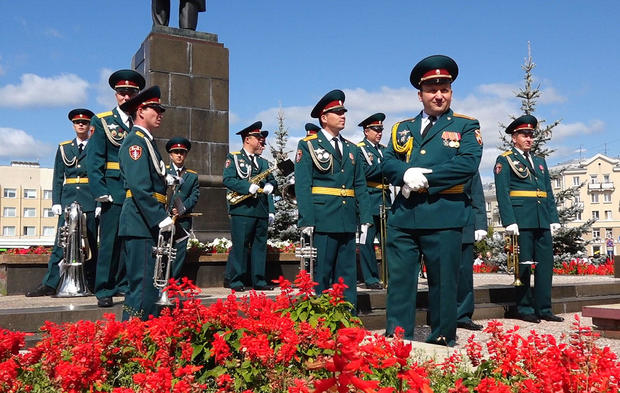Five scientists killed in a mysterious nuclear blast in Northern Russia last week were buried on Monday. Questions remain about the incident, but U.S. officials believe it may have involved work on a new nuclear-powered cruise missile, and could have contaminated the region with radioactive waste.
The scientists were employed by the Russian Federal Nuclear Center, a research institute run by Rosatom, Russia’s state nuclear energy corporation. They were posthumously awarded the Order of Courage, a state award that honors “brave actions committed while performing one’s military, civic or professional duty with risks to one’s life.”
“We laid to rest our colleagues that tragically died testing a new special product,” Alexei Likhachyov, head of Rosatom, said in a statement Monday. “They passed like true heroes.”
Trending News
He didn’t clarify what kind of “special product” his employees were testing, fueling speculation that it may have involved a new weapons system and done more damage than reported.
From silence to panic
Russia’s Defense Ministry initially claimed the explosion last Thursday was just a test of liquid-fuel rocket engine gone wrong. The Ministry said the blast at a military testing site on the shore of the White Sea had killed two people and injured six, but the word “nuclear” never made an appearance.
The administration of Severodvinsk, a city about 25 miles away from the site, reported radiation readings spiking on its website within hours of the incident. The report was later deleted, which only fueled suspicion about the blast.
The next morning, local port authorities declared nearby Dvinsky Bay closed to shipping for a month. According to the Reuter news agency, a team from the East Asia Non-Proliferation Program at the Middlebury Institute of International Studies identified the nuclear fuel carrier ship Serebryanka inside an “exclusion” zone near where they explosion occurred. The vessel is often used to collect radioactive waste.
At the same time, anonymous posts on the Telegram messaging app included videos showing what appeared to be people in hazmat suits tending to the injured. Users claimed that several people were transported to a specialized Moscow hospital with severe radiation poisoning.
Igor Orlov, the governor of the Arkhangelsk region where Severodvisnk is located, tried to calm the public by saying radiation levels in the region were normal. “It was confirmed by all government agencies, all monitoring systems,” he said.
But by Friday evening, pharmacies in Severodvinsk and Arkhangelsk had run out of iodine, as concerned residents rushed to take precautions against radiation poisoning and stock up on medicine that can mitigate damage of radiation.
“Radioisotope energy source”
Statements released by Rosatom and Russian Federal Nuclear Center over the weekend shed little light on what happened. Both admitted that the mysterious rocket engine had a nuclear element to it and this nuclear element caused the accident and killed five scientists, in addition to two military personnel.
“The tragedy occurred when engineering and maintenance works on isotope power sources in a liquid propulsion system were being carried out,” Rosatom said in a statement.
Vyacheslav Solovyov, the center’s scientific director, added in an interview to a local TV channel that researchers have been working on “small-scale sources of energy based on radioactive materials — fissile, radioisotope materials.” He added that other countries, including the U.S., were also working on “small nuclear reactors,” appearing to suggest that what exploded near Severodvinsk, was, in fact, a small reactor.
However, spokespeople for Rosatom disagreed with this interpretation and told reporters that the term “reactor” has nothing to do with what happened. “It was basically a nuclear battery,” they were quoted as saying by the Fontanka newspaper.
Nonetheless, Russia’s state-run weather agency reported on Tuesday that immediately following the explosion, radiation levels in Severodvinsk had spiked to up to 16 times the normal reading, according to the TASS news agency, which is also run by the Russian government.
Little information available
There is no consensus among analysts as to what really happened in the Arkhangelsk region, but CBS News national security correspondent David Martin learned late Monday that U.S. intelligence officials believe it “likely” was a test of Russia’s nuclear-powered “Skyfall” cruise missile.
Some analysts also have suggested it was a failed test of the SSC-X-9 Skyfall, known in Russia as the 9M730 Burevestnik. President Vladimir Putin boasted in a 2018 speech about a new, experimental nuclear-powered cruise missile with virtually unlimited range and the ability to penetrate U.S. missile defense systems. He spoke as an animation showed the hypothetical weapon striking Florida. At that time, Martin noted, U.S. officials dismissed the notion that Russia might have any such weapon near operational.
Officials told Martin it was not clear at what stage of the test last Thursday — before or after launch — the explosion occurred. The U.S. officials confirmed that higher levels of radiation were detected in area.
Some analysts have remained skeptical, however, about whether such an advanced weapon even exists.
“All my knowledge and experience says that it doesn’t,” Pavel Luzin, a defense industry expert at Russia’s Perm State University, told CBS News. “Its (characteristics are) simply against the laws of physics.”
According to Luzin, small nuclear power sources — reactors or radioisotope thermoelectric generators — are used in spacecraft, but with the little information available, he said it was impossible to tell which type of power source was used or what it was tested for when the explosion occurred.
Several Russian military experts refused to comment to CBS News, citing the lack of reliable information.
The extent of the damage to the region remains unclear, too. Greenpeace Russia urged authorities to “establish the cause for the increase of radiation levels and study the consequences for both the local residents and the environment.”


